
The 4th Marine Division is a reserve division in the United States Marine Corps. It was raised in 1943 for service during World War II, and subsequently fought in the Pacific against the Japanese. Deactivated after the war, the division was re-formed in 1966 and elements of the division deployed during the Gulf War in 1990–1991, as well as during the Iraq War. It is currently the ground combat element of the Marine Forces Reserve and is headquartered in New Orleans, Louisiana, and has units throughout the United States.

The 5th Marine Regiment is an infantry regiment of the United States Marine Corps based at Marine Corps Base Camp Pendleton, California. It is the most highly decorated regiment in the Marine Corps and falls under the command of the 1st Marine Division and the I Marine Expeditionary Force.

3rd Battalion, 11th Marines (3/11) is an artillery battalion comprising three firing batteries, a Liaison Unit, and a headquarters battery. The battalion is based at the Marine Corps Air Ground Combat Center Twentynine Palms, California and its primary weapon system is the M777 lightweight howitzer with a maximum effective range of 25 miles. They fall under the 11th Marine Regiment and the 1st Marine Division.

The 10th Marine Regiment is an artillery regiment of the United States Marine Corps based at Marine Corps Base Camp Lejeune, North Carolina. They fall under the command of the 2nd Marine Division and the II Marine Expeditionary Force.
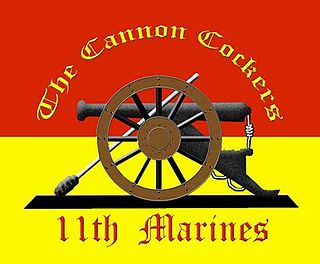
The 11th Marine Regiment is an artillery regiment of the United States Marine Corps based at Marine Corps Base Camp Pendleton, California. Known as the "Cannon Cockers", the regiment falls under the command of the 1st Marine Division and the I Marine Expeditionary Force. Its primary weapon system is the M777A2 howitzer with a maximum effective range of 30 km, however the 5th Battalion has converted to fire the HIMARS weapon system.

1st Battalion, 11th Marines (1/11) is an artillery battalion comprising five firing batteries and a Headquarters battery. The battalion is stationed at the Marine Corps Base Camp Pendleton in California. Its primary weapon system is the M142 HIMARS rocket artillery launcher and the M777 lightweight howitzer. The battalion is under the command of the 11th Marine Regiment, part of the 1st Marine Division.

2nd Battalion, 11th Marines (2/11) is an artillery battalion comprising four firing batteries and a Headquarters Battery. The battalion is stationed at Marine Corps Base Camp Pendleton, California. Its primary weapon system is the M777 lightweight howitzer. The battalion was the first in the Marine Corps to fully transition from the M198 Howitzer. They fall under the command of the 11th Marine Regiment and the 1st Marine Division.

5th Battalion, 11th Marines (5/11) was a High Mobility Artillery Rocket System (HIMARS) battalion consisting of four Firing Batteries and a Headquarters Battery. The battalion is stationed at Marine Corps Base Camp Pendleton, California. It is the first active duty HIMARS Unit in the Marine Corps. They fall under the command of the 11th Marine Regiment and the 1st Marine Division. This is the only battalion in the 11th Marine Regiment not using the M777A2 lightweight howitzer.
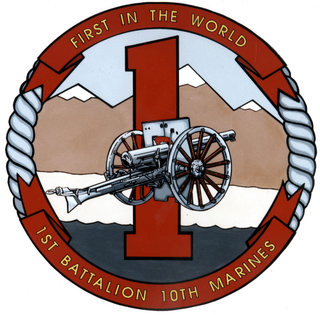
1st Battalion, 10th Marines (1/10) is an artillery battalion composed of five firing batteries and a headquarters battery. The battalion is stationed at Camp Lejeune, North Carolina and falls under the command of 10th Marine Regiment, part of 2d Marine Division. Its primary weapon system is the M777A2 155 mm lightweight howitzer.

5th Battalion 10th Marines (5/10) was a US artillery battalion comprising three firing batteries and a headquarters battery. The battalion was stationed at Marine Corps Base Camp Lejeune, North Carolina, USA and its primary weapon system was the M777A2 howitzer, with a maximum effective range of 30 km. They fell under the command of the 10th Marine Regiment and the 2nd Marine Division. The battalion was known by its nickname of, "The Five and Dime."
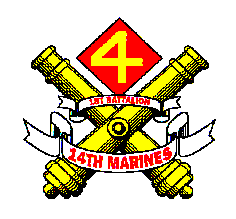
1st Battalion 14th Marines (1/14) was a reserve artillery battalion comprising three firing batteries and a headquarters battery. The battalion was based in Alameda, California. Its primary weapon system was the M198 Howitzer. It was part of the 14th Marine Regiment of the 4th Marine Division.

3rd Battalion, 14th Marine Regiment (3/14) is a reserve artillery battalion comprising four firing batteries and a headquarters battery. The battalion is based in Bristol, Pennsylvania and its primary weapon system is the M777 howitzer with a maximum effective range of 30 km. They fall under the command of the 14th Marine Regiment and the 4th Marine Division.

5th Battalion, 14th Marines (5/14) is a reserve artillery battalion of the United States Marine Corps comprising four firing batteries and a headquarters battery. The battalion is based in Seal Beach, California and its primary weapon system is the M777A2 howitzer with a maximum effective range of 40 km. They fall under the command of the 14th Marine Regiment and the 4th Marine Division.
82nd Field Artillery Regiment is a field artillery regiment of the United States Army. The regiment has been involved in American conflicts dating back to the Mexican Civil War, as well as modern operations such as the War on Terrorism. There are two active and three inactive battalions in the regiment. Traditionally, the regiment has been aligned with the 1st Cavalry Division at Fort Cavazos, Texas and Fort Bliss, Texas.
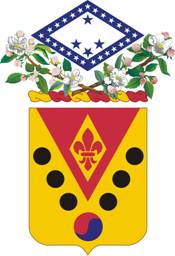
The 142nd Field Artillery Regiment is a United States Army field artillery regiment currently represented in the Arkansas Army National Guard by the 1st Battalion, 142nd Field Artillery, headquartered in Bentonville, Arkansas; 2nd Battalion, 142nd Field Artillery, headquartered in Barling, Arkansas; and Battery F, 142nd Field Artillery stationed in Fayetteville, Arkansas, elements of the 142nd Field Artillery Brigade which is headquartered in Fayetteville, Arkansas. The regiment was created in 1917 from the former 2nd Arkansas Infantry. The 142nd Field Artillery shipped to France during World War I but did not see combat before the cessation of hostilities. The regiment was activated for World War II, but its battalions were redesignated as separate battalions, 1–142nd became the 936th Field Artillery Battalion, the 2–142nd became the 937th Field Artillery Battalion. The battalion's served throughout the European Theater of Operations. The battalions were activated again for the Korean War and served throughout the war. Following the Korean War, the separate battalions resumed their former designations of 1–142nd FA and 2–142nd FA. The 142nd Field Artillery Brigade, including both battalions, was activated for Operation Desert Storm. Elements of the 142nd Fires Brigade have been activated for service in Operation Noble Eagle and Operation Iraqi Freedom. The 142nd Fires Brigade was instrumental in support and recovery operations located in New Orleans, Louisiana after hurricanes Katrina and Rita devastated the Gulf Coast.

The 75th Field Artillery Brigade is an artillery brigade in the United States Army. It is currently based in Fort Sill, Oklahoma and supports the III Armored Corps. The brigade is officially tasked to train and prepares for combat; on orders deploys to any area of operations to plan, synchronize and execute combined, and joint fires and effects. Integrate attached ground and air maneuver forces and on order function as a maneuver headquarters in support of full spectrum operations.
The 258th Field Artillery Regiment or "Washington Greys" is a field artillery unit of the New York Army National Guard that traces its lineage from 1789 to present. Circa 1957–1966 it consisted of four battalions.

The 206th Field Artillery Regiment is a United States artillery regiment, currently represented in the Arkansas Army National Guard by the 1st Battalion, 206th Field Artillery, Headquartered at Russellville, Arkansas. The 1–206th FA is an element of the 39th Infantry Brigade Combat Team.
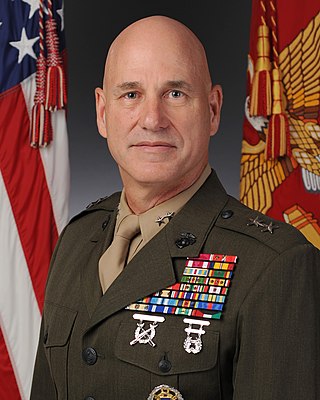
Paul W. Brier is a retired United States Marine Corps major general. A combat veteran of the Persian Gulf, Iraq, and Afghanistan wars, he retired on 31 December 2016, completing 36 years of military service. He holds a BS in Civil Engineering from the Virginia Military Institute and a Master of Strategic Studies from the U.S. Army War College. A 2012 CAPSTONE Fellow at the National Defense University, he is a graduate of the Defense Resources Management Institute, Naval Postgraduate School; Air War College; Joint Forces Staff College; and Marine Corps Command and Staff College.





















